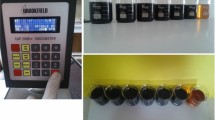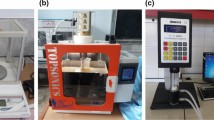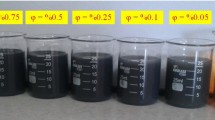Abstract
In the present research, the rheological behavior of MWCNT (50%)-ZnO (50%)/5W50 nanofluid is investigated in the temperature range of 5–55 °C, different solid volume fractions (SVFs) between 0 and 1%, and shear rates (SRs) of 666.5–10,664 s−1. With the aim of preventing unwanted viscosity increase in nano-engine oil and according to test results, the SVF of 0.05% and 0.1% was selected as best choices for having an enriched engine oil containing nanoparticles with improved thermal conductivity and controlled viscosity behavior. Also, to check the sensitivity of nano-engine oil viscosity against unwanted changes in temperature and SVF, a sensitivity analysis was carried out on the produced nano-engine oil. Focusing on the results shows that the lowest sensitivity of viscosity occurs at lower temperatures and SVFs that are about 0.1% and 0.5% at a temperature of 5 °C and SVF of 0.05%, respectively. On the other hand, at higher temperatures and SVFs, the sensitivity of viscosity against temperature and SVF reaches its highest values that are about 1.2% at 55 °C and 6% at SVF of 1%. Based on results SVF of 0.05% is the most suitable enriched nano-engine oil with lowest viscosity influens level against dispersed nanoparticles and also with low level of sensitivity. Proposing a mathematical-based correlation is another achievement of the present study to predict the rheological behavior of nano-engine oil.
Graphic abstract













Similar content being viewed by others
Abbreviations
- f :
-
Frequency
- m :
-
Consistency index
- n :
-
Power law index
- T :
-
Temperature
- W :
-
Mass
- Exp:
-
Experimental
- MOD:
-
Margin of deviation
- MWCNT:
-
Multiwall carbon nanotube
- NF:
-
Nanofluid
- NP:
-
Nanoparticle
- Pred.:
-
Prediction
- SR:
-
Shear rate
- SVF:
-
Solid volume fraction
- SVF:
-
Solid volume fraction
- SS:
-
Shear stress
- SSA:
-
Specific surface area
- TEM:
-
Transmission electron microscopy
- VF:
-
Volume fraction
- VI:
-
Viscosity
- XRD:
-
x-ray diffraction
- ZNO:
-
Zinc oxide
- φ :
-
Solid volume fraction
- \(\dot{\gamma }\) :
-
Shear rate
- μ :
-
Viscosity
- μ r :
-
Relative viscosity
- ρ :
-
Density
- τ:
-
Shear stress
- bf:
-
Basefluid
- nf:
-
Nanofluid
- r :
-
Relative
References
Abbasian Arani AA, Abbaszadeh M, Ardeshiri AJ. Mixed convection fluid flow and heat transfer and optimal distribution of discrete heat sources location in a cavity filled with nanofluid. Transp Phenom Nano Micro Scales. 2016;5(1):30–43.
Esfe MH, Esforjani SSM, Akbari M, Karimipour A. Mixed-convection flow in a lid-driven square cavity filled with a nanofluid with variable properties: effect of the nanoparticle diameter and of the position of a hot obstacle. Heat Trans Res. 2014;45(6):563–78.
Esfe MH, Saedodin S, Rejvani M, Shahram J. Experimental investigation, model development and sensitivity analysis of Rheological behavior of ZnO/10W40 nano-lubricants for automotive applications. Physica E: Low-dimens Syst Nanostruct. 2017;90:194–203.
Esfe MH, Saedodin S, Mahian O, Wongwises S. Efficiency of ferromagnetic nanoparticles suspended in ethylene glycol for applications in energy devices: effects of particle size, temperature, and concentration. Int Comm Heat Mass Trans. 2014;58:138–46.
Esfe MH, Rostamian H, Sarlak MR, Rejvani M, Alirezaie A. Rheological behavior characteristics of TiO2-MWCNT/10w40 hybrid nano-oil affected by temperature, concentration and shear rate: an experimental study and a neural network simulating. Physica E: Low-dim Syst Nanostruct. 2017;94:231–40.
Esfe MH, Hajmohammad MH, Razi P, Ahangar MRH, Arani AAA. The optimization of viscosity and thermal conductivity in hybrid nanofluids prepared with magnetic nanocomposite of nanodiamond cobalt-oxide (ND-Co3O4) using NSGA-II and RSM. Int Comm Heat Mass Trans. 2016;79:128–34.
Esfe MH, Zabihi F, Rostamian H, Esfandeh S. Experimental investigation and model development of the non-Newtonian behavior of CuO-MWCNT-10w40 hybrid nano-lubricant for lubrication purposes. J Mol Liq. 2018;249:677–87.
Esfe MH, Bahiraei M, Hajmohammad MH, Afrand M. Rheological characteristics of MgO/oil nanolubricants: experimental study and neural network modeling. International Communications in Heat and Mass Transfer. 2017;86:245–52.
Nadooshan AA, Esfe MH, Afrand M. Prediction of Rheological behavior of SiO2-MWCNTs/10W40 hybrid nanolubricant by designing neural network. J Therm Anal Calorim. 2018;131(3):2741–8.
Esfe MH, Arani AAA, Rezaie M, Yan WM, Karimipour A. Experimental determination of Thermal conductivity and dynamic viscosity of Ag–MgO/water hybrid nanofluid. Int Comm Heat Mass Trans. 2015;66:189–95.
Esfe MH, Rostamian H, Esfandeh S, Afrand M. Modeling and prediction of Rheological behavior of Al2O3-MWCNT/5W50 hybrid nano-lubricant by artificial neural network using experimental data. Physica A: Stat Mech Appl. 2018;510:625–34.
Eshaghi A, Mojab M. Hydrophilicity of Silica Nano-Porous Thin Films: Calc fects of multi-walled carbon nanotubes on rheological behavior of engine ination Temperature Effects. J Nanostr. 2017;7(2):127–33.
Ehteram HR, Abbasian AA, Sheikhzadeh GA, Aghaei A, Malihi AR. The effect of various conductivity and viscosity models considering Brownian motion on nanofluids mixed convection flow and heat transfer. Transp Phenom Nano Micro Scales. 2016;4(1):19–28.
Hamid KA, Azmi WH, Nabil MF, Mamat R, Sharma KV. Experimental investigation of thermal conductivity and dynamic viscosity on nanoparticle mixture ratios of TiO2-SiO2 nanofluids. Int J Heat Mass Transf. 2018;116:1143–52.
Ghasemi S, Karimipour A. Experimental investigation of the effects of temperature and mass fraction on the dynamic viscosity of CuO-paraffin nanofluid. Appl Therm Eng. 2016;128:189–97.
Moldoveanu GM, Ibanescu C, Danu M, Minea AA. Viscosity estimation of Al2O3, SiO2 nanofluids and their hybrid: an experimental study. J Mol Liq. 2018;253:188–96.
Dehghani Y, Abdollahi A, Karimipour A. Experimental investigation toward obtaining a new correlation for viscosity of WO 3 and Al 2O3 nanoparticles-loaded nanofluid within aqueous and non-aqueous basefluids. J Therm Anal Calorim. 2019;135(1):713–28.
Mousavi SM, Esmaeilzadeh F, Wang XP. Effects of temperature and particles volume concentration on the thermophysical properties and the rheological behavior of CuO/MgO/TiO2 aqueous ternary hybrid nanofluid. J Therm Anal Calorim. 2019;137(3):879–901.
Esfe MH, Emami MR, Amiri MK. Experimental investigation of effective parameters on MWCNT–TiO 2/SAE50 hybrid nanofluid viscosity. J Therm Anal Calorim. 2019;137(3):743–57.
Mehryan SA, Izadi M, Namazian Z, Chamkha AJ. Natural convection of multi-walled carbon nanotube–Fe 3 O 4/water magnetic hybrid nanofluid flowing in porous medium considering the impacts of magnetic field-dependent viscosity. J Therm Anal Calorim. 2019;138(2):1541–55.
Ahmadi MH, Baghban A, Ghazvini M, Hadipoor M, Ghasempour R, Nazemzadegan MR. An insight into the prediction of TiO 2/water nanofluid viscosity through intelligence schemes. J Therm Anal Calorim. 2020;139(3):2381–94.
Ahmadi MH, Mohseni-Gharyehsafa B, Ghazvini M, Goodarzi M, Jilte RD, Kumar R. Comparing various machine learning approaches in modeling the dynamic viscosity of CuO/water nanofluid. J Therm Anal Calorim. 2020;139(4):2585–99.
Pourpasha H, Heris SZ, Asadi A. Experimental investigation of nano-TiO 2/turbine meter oil nanofluid. J Therm Anal Calorim. 2019;138(1):57–67.
Chen Z, Liu P, Zare A, Karimipour A, Abdollahi A, Tlili I. 2019 Evaluation of thermal conductivity of deionized water containing SDS-coated NiO nanoparticles under the influences of constant and alternative varied magnetic fields. Powder Technol. 2020;138(1):57–67.
Li Z, Asadi S, Karimipour A, Abdollahi A, Tlili I. Experimental study of temperature and mass fraction effects on thermal conductivity and dynamic viscosity of SiO2-oleic acid/liquid paraffin nanofluid. Int Commun Heat Mass Transfer. 2020;110:104436.
Esfe MH, Rostamian H, Shabani-Samghabadi A, Arani AAA. Application of three-level general factorial design approach for thermal conductivity of MgO/water nanofluids. Appl Therm Eng. 2017;127:1194–9.
Esfe MH, Saedodin S, Biglari M, Rostamian H. Experimental investigation of thermal conductivity of CNTs-Al2O3/water: a statistical approach. Int Comm Heat Mass Trans. 2015;69:29–33.
Esfe MH, Motallebi SM. Optimization, modeling, and prediction of relative viscosity and relative thermal conductivity of AlN nano-powders suspended in EG. European Phys J Plus. 2021;136(1):1–19.
Esfe MH, Yan WM, Akbari M, Karimipour A, Hassani M. Experimental study on Thermal conductivity of DWCNT-ZnO/water-EG nanofluids. Int Comm Heat Mass Trans. 2015;68:248–51.
Esfe MH, Hosseinizadeh E, Esfandeh S. Flooding numerical simulation of heterogeneous oil reservoir using different nanoscale colloidal solutions. J Mol Liquids. 2020;302:111972.
Esfe MH, Esfandeh S, Hosseinizadeh E. Nanofluid flooding for enhanced oil recovery in a heterogeneous two-dimensional anticline geometry. Int Comm Heat Mass Trans. 2020;118:104810.
Esfe MH, Esfandeh S, Hosseinizadeh E. Nanofluid flooding in a randomized heterogeneous porous media and investigating the effect of capillary pressure and diffusion on oil recovery factor. J Mol Liquids. 2020;320:113646.
Afrand M, Najafabadi KN, Akbari M. Effects of temperature and solid volume fraction on viscosity of SiO2-MWCNTs/SAE40 hybrid nanofluid as a coolant and lubricant in heat engines. Appl Thermal Eng. 2017;102:45–54.
Moghaddam MA, Motahari K. Experimental investigation, sensitivity analysis and modeling of rheological behavior of MWCNT-CuO (30–70)/SAE40 hybrid nano-lubricant. Appl Therm Eng. 2017;123:1419–33.
Ettefaghi E, Rashidi A, Ahmadi H, Mohtasebi SS, Pourkhalil M. Thermal and rheological properties of oil-based nanofluids from different carbon nanostructures. Int Commun Heat Mass Transfer. 2013;48:178–82.
Nadooshan AA, Esfe MH, Afrand M. Evaluation of rheological behavior of 10W40 lubricant containing hybrid nano-material by measuring dynamic viscosity. Phys E. 2017;92:47–54.
Hemmat Esfe M, Rostamian H, Afrand M, Wongwises S. Examination of effects of multi-walled carbon nanotubes on rheological behavior of engine oil (10W40). J Nanostr. 2016;6(4):257–63.
Esfe MH, Sarlak MR. Experimental investigation of switchable behavior of CuO-MWCNT (85%–15%)/10W40 hybrid nano-lubricants for applications in internal combustion engines. J Mol Liq. 2017;242:326–35.
Esfe MH, Karimpour R, Arani AA, Shahram J. Experimental investigation on non-Newtonian behavior of Al2O3-MWCNT/5W50 hybrid nano-lubricant affected by alterations of temperature, concentration and shear rate for engine applications. Int Commun Heat Mass Transfer. 2017;82:97–102.
Alirezaie A, Saedodin S, Esfe MH, Rostamian SH. Investigation of rheological behavior of MWCNT (COOH-functionalized)/MgO-engine oil hybrid nanofluids and modelling the results with artificial neural networks. J Mol Liq. 2017;241:173–81.
Jiang Y, Bahrami M, Bagherzadeh SA, Abdollahi A, Sulgani MT, Karimipour A, Goodarzi M, Bach QV. Propose a new approach of fuzzy lookup table method to predict Al2O3/deionized water nanofluid thermal conductivity based on achieved empirical data. Phys A. 2019;527:121177.
He W, Bagherzadeh SA, Tahmasebi M, Abdollahi A, Bahrami M, Moradi R, Karimipour A, Goodarzi M, Bach QV. A new method of black-box fuzzy system identification optimized by genetic algorithm and its application to predict mixture thermal properties. Int J Numer Methods Heat Fluid Flow. 2019. https://doi.org/10.1108/HFF-12-2018-0758
Tian Z, Bagherzadeh SA, Ghani K, Karimipour A, Abdollahi A, Bahrami M, Safaei MR. Nonlinear function estimation fuzzy system (NFEFS) as a novel statistical approach to estimate nanofluids’ thermal conductivity according to empirical data. Int J Numer Methods Heat Fluid Flow. 2019. https://doi.org/10.1108/HFF-12-2018-0768
Esfe MH, Motallebi SM. Four objective optimization of aluminum nanoparticles/oil, focusing on thermo-physical properties optimization. Powder Technol. 2019;356:832–46.
Esfe MH, Arani AAA, Badi RS, Rejvani M. ANN modeling, cost performance and sensitivity analyzing of thermal conductivity of DWCNT–SiO2/EG hybrid nanofluid for higher heat transfer. J Therm Anal Calorim. 2018;131(3):2381–93.
Esfe MH, Wongwises S, Naderi A, Asadi A, Safaei MR, Rostamian H, Dahari M, Karimipour A. Thermal conductivity of Cu/TiO2–water/EG hybrid nanofluid: Experimental data and modeling using artificial neural network and correlation. Int comm heat mass trans. 2015;66:100–4.
Ganapathy S, Viswanathan KR, Raju S, Appancheal AK. Comparative study of different nanolubricants for automotive applications. SAE Technical Paper. 2016.
Sepyani K, Afrand M, Esfe MH. An experimental evaluation of the effect of ZnO nanoparticles on the rheological behavior of engine oil. J Mol Liq. 2017;236:198–204.
Esfe MH, Afrand M, Rostamian SH, Toghraie D. Examination of rheological behavior of MWCNTs/ZnO-SAE40 hybrid nano-lubricants under various temperatures and solid volume fractions. Exp Thermal Fluid Sci. 2017;80:384–90.
Esfe MH, Arani AAA, Esfandeh S. Improving engine oil lubrication in light-duty vehicles by using of dispersing MWCNT and ZnO nanoparticles in 5W50 as viscosity index improvers (VII). Appl Therm Eng. 2018;143:493–506.
Esfe MH, Esfandeh S, Arani AAA. Proposing a modified engine oil to reduce cold engine start damages and increase safety in high temperature operating conditions. Powder Technol. 2019;355:251–63.
Esfe MH, Arani AAA, Esfandeh S, Afrand M. Proposing new hybrid nano-engine oil for lubrication of internal combustion engines: Preventing cold start engine damages and saving energy. Energy. 2019;170:228–38.
Author information
Authors and Affiliations
Corresponding author
Additional information
Publisher's Note
Springer Nature remains neutral with regard to jurisdictional claims in published maps and institutional affiliations.
Rights and permissions
About this article
Cite this article
Hemmat Esfe, M., Esfandeh, S. Mathematical based modeling of thermophysical properties of an enriched oil based hybrid nanofluid. J Therm Anal Calorim 147, 2125–2137 (2022). https://doi.org/10.1007/s10973-020-10497-1
Received:
Accepted:
Published:
Issue Date:
DOI: https://doi.org/10.1007/s10973-020-10497-1




